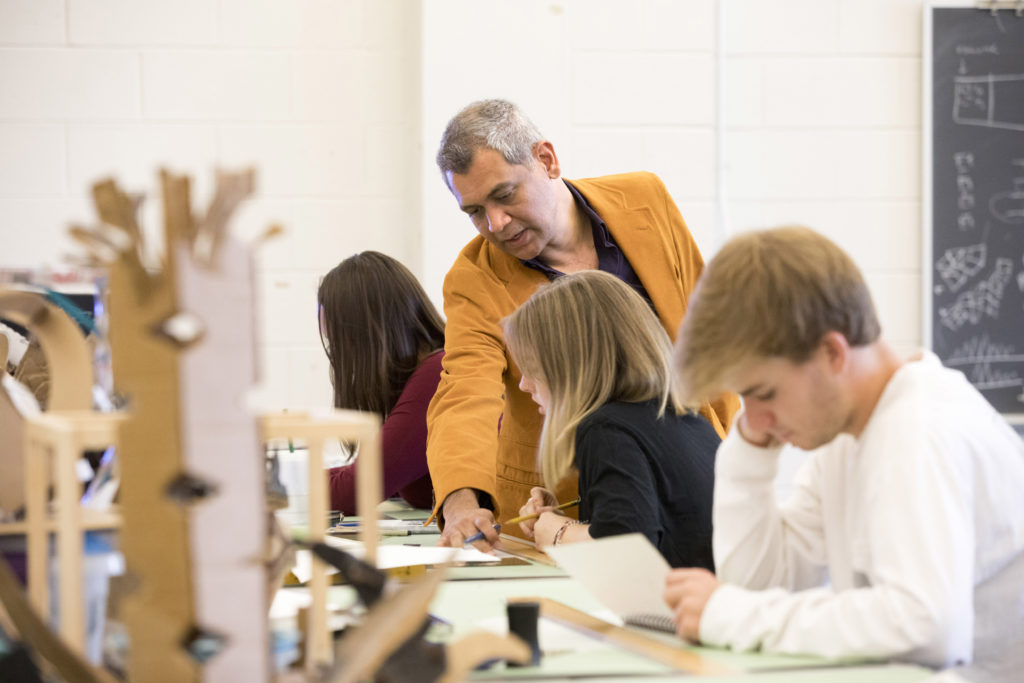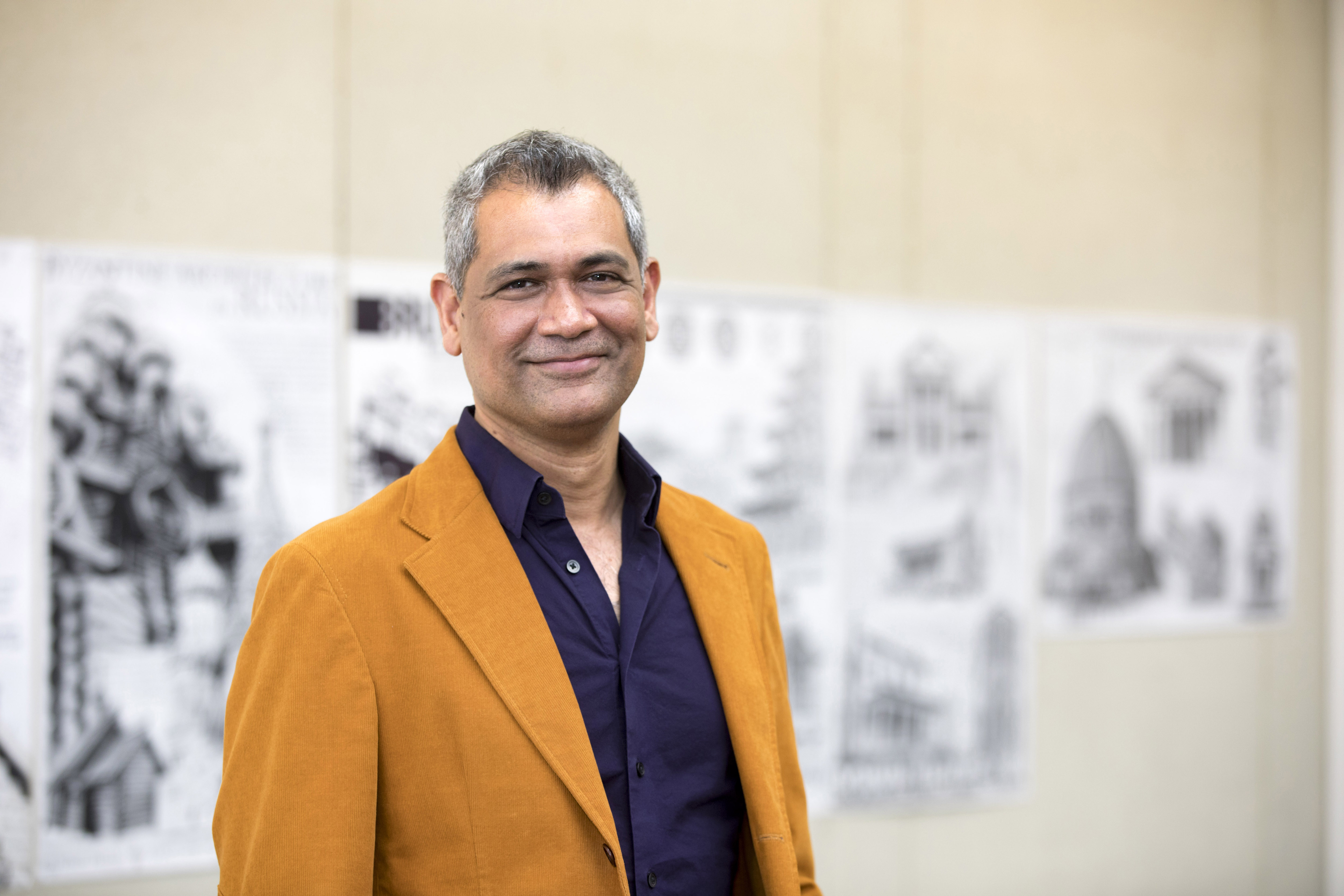Amitabh Verma, an associate professor in the College of Environment and Design, incorporates community projects as assignments in his classes, such a courtyard design for Clarke Central High School in Athens.
Where did you earn degrees and what are your current responsibilities at UGA?
My undergraduate degree is from Sir JJ College of Architecture in Mumbai, India, and my graduate degree in landscape architecture is from UGA.
I teach many subjects in the College of Environment and Design, including “Urban Design,” “Architecture,” “Senior Capstone Studio,” and my favorite, “Manual Graphics,” which is drawing, sketching, lettering and drafting. I also am the faculty advisor for our student publication, Georgia Magazine, a role that I enjoy tremendously. Within the college, I’m on two committees—communications and branding—for our upcoming 50th anniversary. My service at the university level includes serving on the President’s Faculty Advisory Committee and representing the college for the Innovation District.
When did you come to UGA and what brought you here?
This is my second stint at UGA. The first time was as a graduate student in 1992. After studying architecture in India, I wanted to study landscape architecture and applied to several schools across the United States. I chose Georgia because it had an excellent program, and I received a full scholarship. It also turned out to be just like home, weather-wise.
This time around, I began teaching in 2006 after being in professional practice for 12 years. Working at a firm was a valuable experience, but it was largely focused on the technical aspects of construction, management and implementation. I’m more drawn to the philosophical, big-picture side of design and what it can do for our communities.
What are your favorite courses and why?
I like teaching “Urban Design” because it allows me to show my students how much we shape our environment and how much it shapes us. We discuss cities, towns, neighborhoods, streets, parks, what they mean and how they enrich our lives. We discuss strategies to make them better. We talk about why New York City and Paris are what they are and why other cities are not.
Drawing classes are my favorite because I’m teaching a skill, which is the foundation of our work as designers. For a similar reason, another favorite is my First-Year Odyssey Seminar, “Understanding Architecture through Drawing and Sketching.” I came up with the idea when I realized that many UGA students don’t get a chance to learn about the extraordinary architectural heritage on our campus. Now they get to know these buildings by sketching them, and learn what they are saying to us.
What are some highlights of your career at UGA?
It’s been an extraordinary and invaluable experience in many ways, and I have found every aspect of it very rewarding. Learning to teach was an accomplishment for me, as I had never done it before. Similarly, conducting research, writing and publishing were new to me as well. Adding them to my list of abilities is definitely the highlight of my career here.
Another thing I appreciate is how many of my former students have become my friends. Many former students keep in touch with me, and it is satisfying to see them continue to succeed, achieve and grow. I value these friendships very much.
How do you describe the scope and impact of your research or scholarship to people outside of your field?
I have two areas of research, fortunately both subjects that people know well, so it doesn’t take much explanation on my part. One, I study ways to make our cities better—more attractive, functional, environmentally conscious, responsive to the way we live—and that’s obviously part of everyone’s personal experience, so it makes for good and easy conversation.
My second area of research is the value of manual graphics (sketching, drawing, writing by hand) in today’s world, which is dominated by technology. That’s also an issue that people like and understand, so that takes no effort from me either. They usually have strong opinions on this subject, but always agree with me, thankfully.

How does your research or scholarship inspire your teaching, and vice versa?
Because I teach design studios, my classes are really an extension of my research. There is a lot of discussion, and I get to know each student’s personal perspectives on these topics very well. This helps me see my research in new ways.
For both drawing and urban design, I share the questions and issues I am exploring with my students. Their thoughts and reactions—which are different from mine, yet equally valid—help me see these issues from different viewpoints. I see things I may have missed earlier, or in an entirely new way, and this helps make my arguments more solid, more relevant.
What do you hope students gain from their classroom experience with you?
I am very enthusiastic about design, and I hope they pick up some of this enthusiasm from me. It’s a creative, fun and meaningful line of work, and a rare opportunity to make things better. At the same time, it’s also a big responsibility toward our community and our environment, and it needs to be taken seriously.
I also want them to realize that they are fortunate to have a place in a program with the reputation, resources and opportunities that it has. It’s a privilege that not everyone has, and they should always try to make the most of it.
Describe your ideal student.
Someone who is curious about the world and willing to make an effort. That’s all it takes to learn, really.
Favorite place to be/thing to do on campus is …
As our college is located on North Campus, I spend a lot of time on what I consider to be the prettiest part of our university. But I would say my favorite place on campus is Tate Plaza and the area around it. It’s always bustling with crowds, and I really like the energy, color and movement I see there. It’s also the crossroads of the campus, and gives me a sense of who else shares this huge campus with me.
Beyond the UGA campus, I like to …
… socialize, read, make art or travel.
Community/civic involvement includes …
… incorporating community projects as assignments in my classes, such as a courtyard design for Clarke Central High School and the landscape for the Boy Scouts Headquarters in Jefferson, Georgia.
Recently, I have been actively promoting sketching to the larger community through workshops focused on creativity, mental wellness and self-expression. I’ve taught workshops at the University of California, Berkeley, to web designers in San Francisco, to UGA staff, for UGA’s Alumni Weekend, among others. I’m currently teaching a six-week series, “Sketching for Mindfulness,” for the University Health Center and Student Affairs, and will also teach a similar class for OLLI (Osher Lifelong Learning Institute) next March.
To connect with UGA fans globally, the Office of Online Learning and I have created a YouTube channel, “Sketching UGA,” which shows viewers how to sketch the iconic structures on our campus – the Arch, the Chapel, the bell tower. It’s a wonderful way to make these symbols more accessible to people who love them.
Favorite book/movie (and why)?
John Steinbeck’s “The Grapes of Wrath” is a book that affected me like no other. I read it a long time ago, in high school, and it was the first book to make me realize that words had the power to shake you emotionally. It made a huge impression, and I still have that copy, although it’s falling apart.
I am not much of a movie watcher. I mainly watch documentaries; I feel like they are a better use of my time, as I learn new things. The current topic of interest is plant intelligence and communication, and it’s incredible what we are discovering.
The one UGA experience I will always remember will be …
… having my First-Year Odyssey Seminar featured in Georgia Magazine earlier this year. I strongly believe that sketching has valuable benefits for everyone, regardless of age, profession or background. This is especially true now, when our lives are saturated with technology, and that’s why I am engaged in actively promoting it. Getting recognition and support at that level was extremely validating, and seeing my students’ sketches on the cover was a special bonus.
Is there anything else you’d like to add?
The chance to come back to teach at the school where I studied is very special for me. When I came here as a student, all those years ago, I had no idea how much this experience would influence my life. UGA and Athens were my first exposure to a new country, a new culture, a new education system and a new way of thinking. I also met people then who are still close friends of mine. So teaching here gives me a great sense of satisfaction, and it is meaningful in a way it wouldn’t have been anywhere else. It’s not just a job, but a way of giving back.


